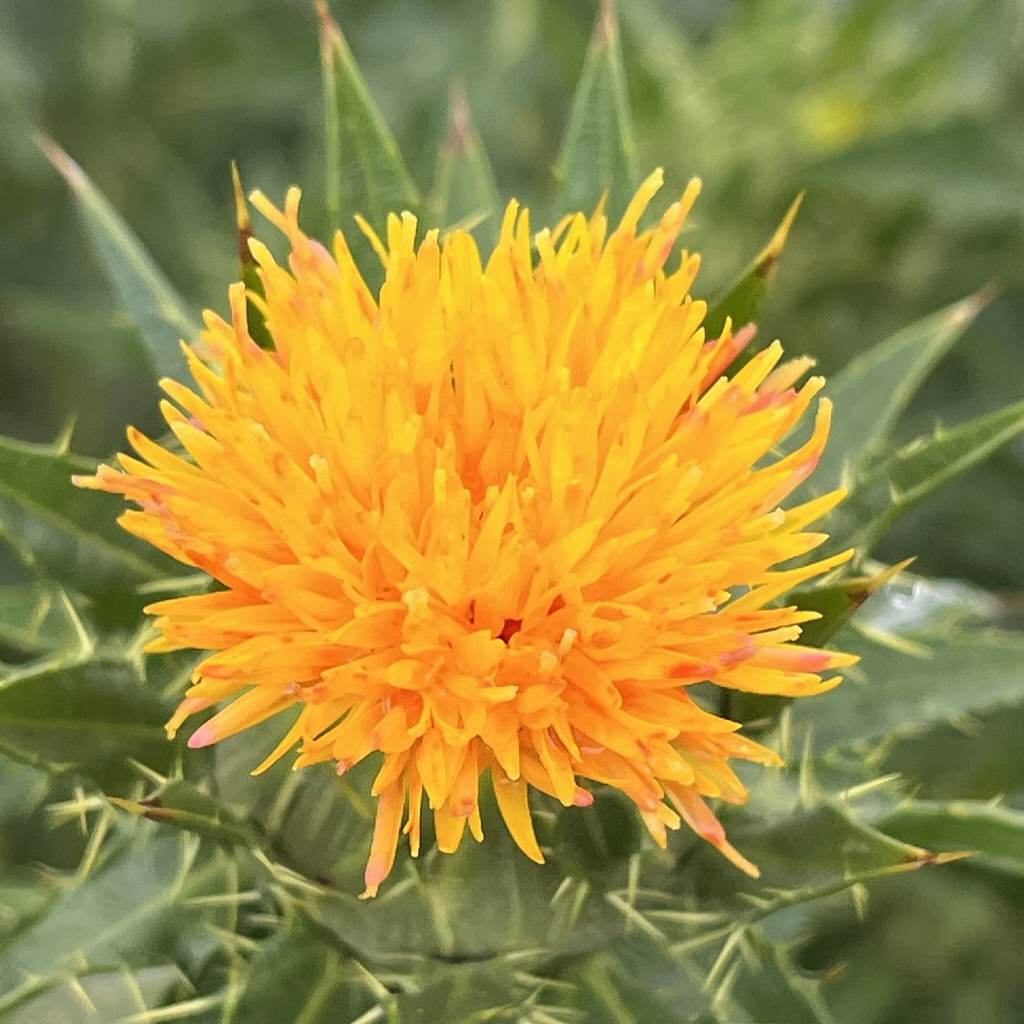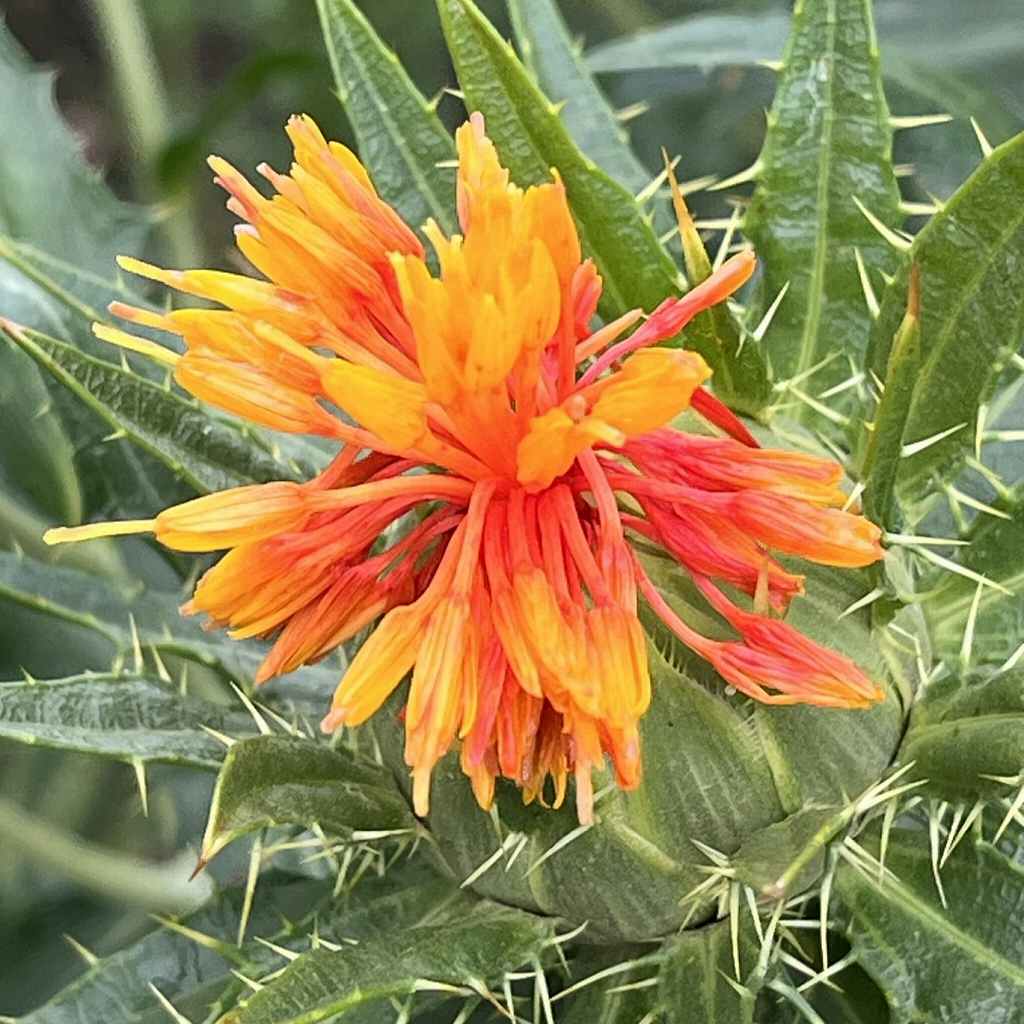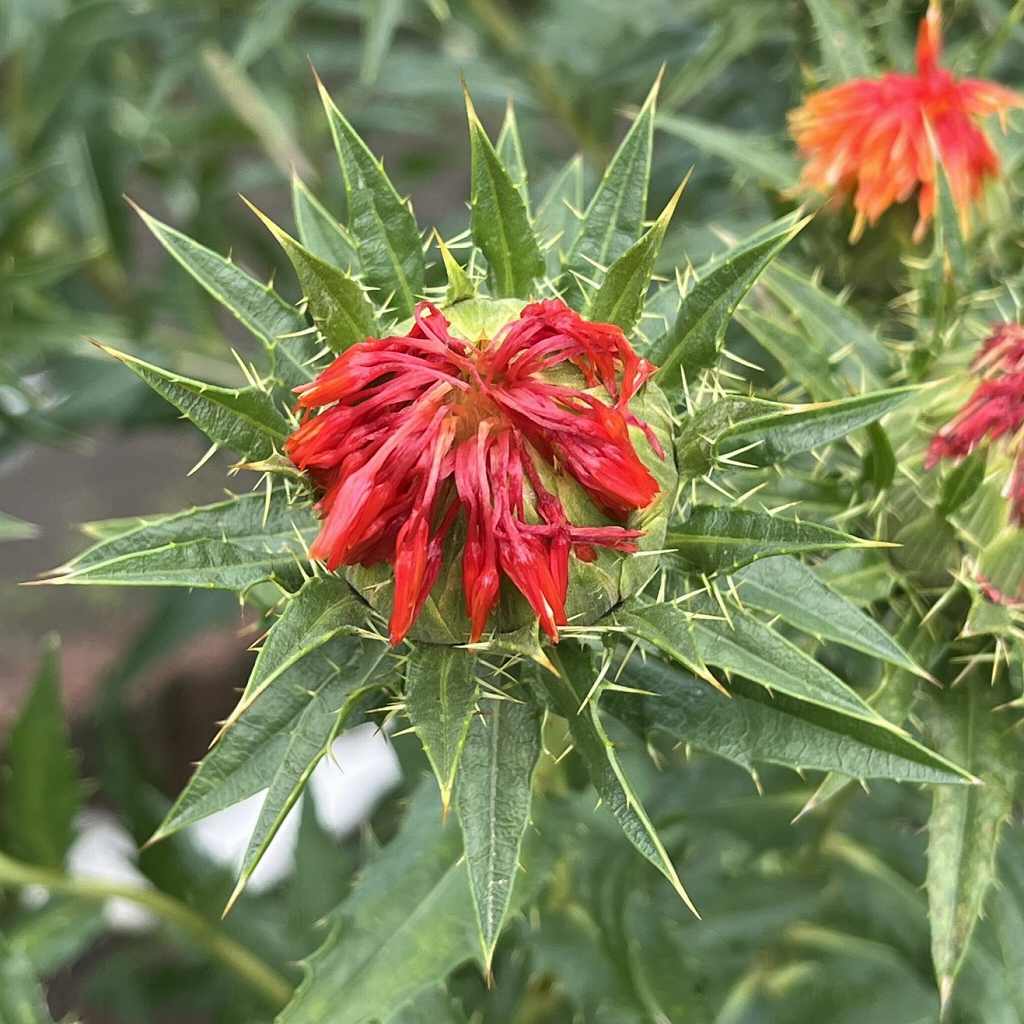ベニバナは『万葉集』で尽きせぬ思いが「紅の八塩」と詠まれ、『源氏物語』で紅鼻の姫が「末摘花」と呼ばれ、古くから身近なお花でした。
Safflower has long been a familiar flower for Japanese people, appearing as a symbol of love in Japan’s oldest collection of poems, “Manyoshu,” and becoming the nickname of a character in Japan’s oldest novel, “The Tale of Genji”.
【仮名】ベニバナ, スエツムハナ
【和名】紅花, 末摘花
【英名】Safflower
【学名】Carthamus tinctorius
【誕生】06/ 11
【開花】05, 06, 07月
【花色】Red, Yellow, Orange




ベニバナ
ベニバナの概要
ベニバナはキク科の1~2年草です。原産地は東アフリカのエチオピアで、中近東、中央アジア、中国、朝鮮半島を経て、日本へは6世紀頃に渡来。『万葉集』では尽きせぬ思いが「紅の八塩」と詠まれ、『源氏物語』では紅鼻の姫が「末摘花」と呼ばれ、古くから身近なお花でした。
ベニバナの名前
ベニバナの名前の由来は花が紅色の染料に用いられたため。「紅」は中国伝来の染料「呉藍」に由来します。別名「末摘花」は茎の末端に咲く花を摘み取るから。ラテン語の属名カルタムスはアラビア語の「染める」に由来し、種小名ティンクトリウスも「染色用の」という意味です。
ベニバナの姿形
ベニバナの茎は下の方で直立し、上の方で盛んに分岐。葉は互生し、硬い革質の広披針形で、先端や縁が鋭く尖ります。花は薊に似て、茎の先端に無数の筒状花が集まって咲き、時間とともに黄色から橙色、赤色へと変化。花後は冠毛のある種子が収められた長球形の痩果を結びます。
ベニバナの染料
ベニバナは染料になります。摘み取った花を日干し後、水に一晩浸漬。水に溶けやすい黄色が染み出し、水に溶けにくい紅色が残ります。この乾燥と水浸を繰り返して「紅餅」に濃縮。この紅餅に「灰汁」を加えると衣類が橙色に染まり、さらに「烏梅」を加えると紅色に染まります。
ベニバナの油脂
ベニバナは種子から油脂が採れます。当初は「豊富な必須脂肪酸がコレステロール値を下げる」ので高評価でしたが、その後「酸化しやすい多価不飽和脂肪酸が動脈硬化を促す」ので低評価に。今は品種改良によってオレイン酸に富み、リノール酸を抑えたものが主流になっています。
ベニバナの食用
ベニバナは花が生薬「紅花」になります。血の巡りをよくする働きがあり、産後の不調、更年期障害など婦人科系の疾患のほか、葛根紅花湯、滋血潤腸湯、通導散に配合。花はお酒やお灸、スープやサラダの彩りに、若葉はお浸しや煮付けに、種子は炒っておつまみなどに供されます。
Safflower
Overview of Safflower
Safflower is an annual or biennial plant belonging to the Asteraceae family. Originating in Ethiopia in East Africa, it was brought to Japan around the 6th century via the Middle East, Central Asia, China, and the Korean Peninsula. Safflower has long been a familiar flower for Japanese people, appearing as a symbol of love in Japan’s oldest collection of poems, “Manyoshu,” and becoming the nickname of a character in Japan’s oldest novel, “The Tale of Genji.”
Name of Safflower
The Japanese name of Safflower means red flower because the flowers were used as a red dye. It is also known as “a flower that blooms at the end of a stem and is picked”. The Latin genus name Carthamus is derived from the Arabic word “to dye”, and the species name Tinctorius also means “for dyeing”.
Shape of Safflower
Safflower stems stand upright in the lower part and branch vigorously in the upper part. The leaves are alternate, broad-lanceolate, leathery, and sharply pointed at the tips and margins. The flower resembles that of Cirsium, and blooms at the tip of a stem with numerous tubular flowers that change color from yellow to orange to red over time. After flowering, it produces long spherical achenes containing pappus seeds.
Safflower dye
Safflower is used for dyeing. After drying the picked flowers in the sun, soak them in water overnight. The yellow color that dissolves easily in water oozes out, and the red color that does not dissolve in water remains. This drying and water soaking are repeated to concentrate the red dough. If you add “lye” to this red dough, your clothes will be dyed orange, and if you add “Ubai”, it will be dyed red.
Safflower oil
Safflower seeds are oily. At first, it was highly rated because “abundant essential fatty acids lower cholesterol levels”, but later it was rated low because “easy-to-oxidize polyunsaturated fatty acids promote arteriosclerosis”. Today, due to selective breeding, the mainstream variety is rich in oleic acid and low in linoleic acid.
Edible Safflower
The flower of Safflower becomes the herbal medicine. It has the effect of improving blood circulation, and is used in various herbal medicines in addition to gynecological diseases such as postpartum disorders and menopausal disorders. The flowers are used for alcoholic beverages, moxibustion, and to add color to soups and salads, the young leaves are boiled, the seeds are roasted and served as snacks.


